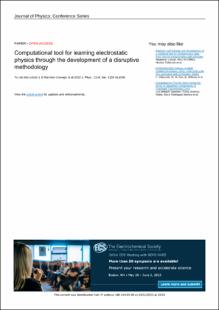Computational tool for learning electrostatic physics through the development of a disruptive methodology
Artículo de revista
2022-01-05
Journal of Physics: Conference Series
Reino Unido
A computational tool for learning electrostatic physics is presented through the
development of a disruptive methodology. The tool allows the analysis of case studies based on
Coulomb’s law, Gauss’s law, Poisson’s equation, and Laplace’s equation with boundary value.
The tool was tested using reference exercises for each case study, making use of quantitative and
qualitative comparative analysis between the traditional mathematical development and the
computational tool. Errors were measured using Likert scale. The quantitative results showed
errors of less than 1.8% in all the cases studied, concluding that the tool is effective. The
qualitative results showed that the methodology allows a better development of the electrostatics
learning process, dynamizing the study of complex topics such as electromagnetic physics
theories through interactivity and technological resources, in addition to having a theoretical
module developed using agile methodologies that provide dynamism and an intuitive
environment to the interface.
- Desarrollo Regional - IDR [20]
- Enseñanza de las Ciencias – Arquímedes [59]
- Grupo de Investigación en Pedagogía y Practicas Pedagógicas - INPEPRA [104]
- Grupo de Investigación y Desarrollo en Electrónica y Telecomunicaciones – GIDET [47]
- Orientación Educativa, Vocacional y Ocupacional – GIOEVO [25]
- Procesos Ambientales - GIPROAM [14]
- Proyección Empresarial - GIPE [5]
- Zulima Science – ZSC [34]
Descripción:
Ramírez-Carvajal_2022_J._Phys.__Conf._Ser._2159_012005.pdf
Título: Ramírez-Carvajal_2022_J._Phys.__Conf._Ser._2159_012005.pdf
Tamaño: 1.004Mb
 PDF
PDF
 LEER EN FLIP
LEER EN FLIP
Título: Ramírez-Carvajal_2022_J._Phys.__Conf._Ser._2159_012005.pdf
Tamaño: 1.004Mb
 PDF
PDF
 LEER EN FLIP
LEER EN FLIP
















